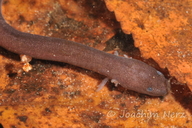|
Amphiuma means Garden, 1821
Two-toed Amphiuma, Conger Eel, Congo Eel, Congo Snake, Lamprey Eel, Ditch Eel, Fish Eel | family: Amphiumidae genus: Amphiuma |
| Species Description: Garden In Smith, J. E. 1821. A Selection of the Correspondence of Linnaeus and Other Naturalists from the Original Manuscripts. Volume 1. London: Longman, Hurst, Rees, Orme and Brown. | |
 © 2017 Dr. Joachim Nerz (1 of 18) |
|
|
|
Description Adult two-toed amphiumas range in size from 46 - 116 cm total length. There are 57 - 60 costal grooves (average 58). The laterally compressed tail is 20-25% of the total body length. The dorsum is black to dark brown or grey and the venter is only slightly lighter (Salthe 1973; Petranka 1998). A dark patch on the chin is difficult to see against the ground coloration (Salthe 1973). The three species of Amphiuma are similar but can be differentiated based on the number of toes (one, two, or three), coloration, and body size. Distribution and Habitat Country distribution from AmphibiaWeb's database: United States U.S. state distribution from AmphibiaWeb's database: Alabama, Florida, Georgia, Louisiana, Mississippi, North Carolina, South Carolina, Virginia
This species is almost completely aquatic, but individuals occasionally move overland on rainy nights (Conant and Collins 1991). Life History, Abundance, Activity, and Special Behaviors Adults consume vertebrate and invertebrate prey, including salamanders, small frogs, crayfish, as well as a range of smaller invertebrates. Amphiumas have a powerful bite. Foraging activities occur at night and during the day animals retreat to underground burrows, sometimes over a meter deep. Important predators of amphiumas are aquatic snakes like mud and rainbow snakes (Farancia), water snakes (Nerodia), cottonmouths (Agkistrodon), and large wading birds. Defensive behavior of amphiumas is primarily bites from their strong jaws. People should take care when handling these animals. See Petranka (1998) and references therein. Two-toed amphiumas often function as top predators in their freshwater systems. Their importance in influencing species diversity and community structure is not known. This would be a productive area of investigation, particularly because the wetland habitats where they occur are threatened with continuing loss (Petranka 1998). Larva Trends and Threats Comments
References
Conant, R. and Collins, J. T. (1991). A Field Guide to Reptiles and Amphibians: Eastern/Central North America. Houghton Mifflin, Boston. Karlin, A. A., and Means, D. B. (1994). ''Genetic variation in the aquatic salamander genus Amphiuma.'' American Midland Naturalist, 132, 1-9. Petranka, J. W. (1998). Salamanders of the United States and Canada. Smithsonian Institution Press, Washington D.C. and London. Salthe, S. N. (1973). ''Amphiuma means Garden. Two-toed Congo Eel.'' Catalogue of American Amphibians and Reptiles. Society for the Study of Amphibians and Reptiles, 148.1-148.2. Salthe, S. N. (1973). ''Amphiuma tridactylum Cuvier. Three-toed Congo Eel.'' Catalogue of American Amphibians and Reptiles. Society for the Study of Amphibians and Reptiles, 149.1-149.3. Originally submitted by: Meredith J. Mahoney (first posted 2000-01-17) Edited by: M. J. Mahoney, Michelle S. Koo (2022-08-18) Species Account Citation: AmphibiaWeb 2022 Amphiuma means: Two-toed Amphiuma <https://amphibiaweb.org/species/3853> University of California, Berkeley, CA, USA. Accessed Nov 24, 2024.
Feedback or comments about this page.
Citation: AmphibiaWeb. 2024. <https://amphibiaweb.org> University of California, Berkeley, CA, USA. Accessed 24 Nov 2024. AmphibiaWeb's policy on data use. |




 Raffaëlli Account
Raffaëlli Account Map of Life
Map of Life